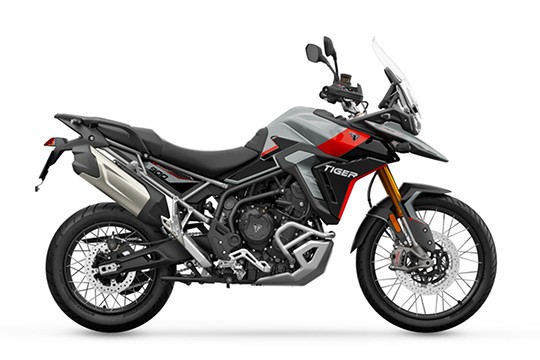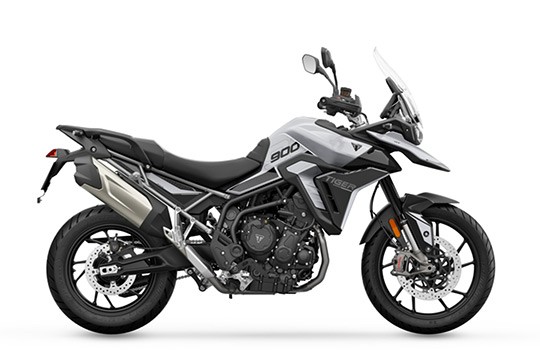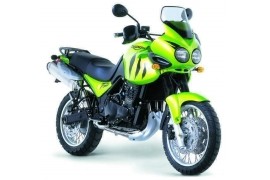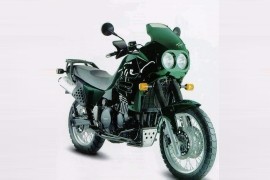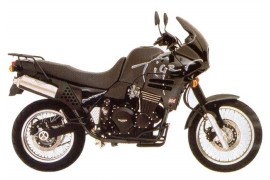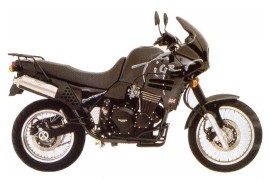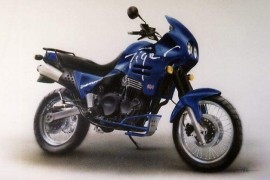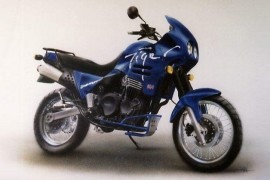TRIUMPH Tiger 900 Models/Series Timeline, Specifications & Photos
First production year: 1993
The Triumph Tiger 900 was a middleweight adventure motorcycle that debuted in 2020 as a successor to the Tiger 800. The range comprised six models, including the base model, GT, GT Low, GT Pro, Rally, and Rally Pro versions.
In 2023, the British motorcycle manufacturer announced the 2024 model year Tiger 900 line-up, comprising the GT, GT Pro, and Rally Pro models, delivering better performance, more all-day comfort, attitude, and more capability.
Dirt-oriented Rally models were intended to handle off-road trails, featuring wire-spoke wheels with tubeless tires. The bike was loaded with top-notch technology, including several riding modes, LED lighting, Triumph Shift Assist, heated seats and grips, and a Tire Pressure Monitoring System.
In the visual department, the Rally Pro model packs standard features, such as a beak fairing, a small windscreen, hand guards, a two-piece dual seat with passenger grab handles, a high-mounted exhaust system, and engine guard, and wire-spoke wheels with tubeless tires.
The 2024 model year Triumph Tiger 900 Rally Pro takes its power from an 888cc four-stroke liquid-cooled three-cylinder engine with a fuel injection system in charge, delivering an output power of 108 hp at 9,500 rpm and 89 Nm (66 lb-ft) torque at 6,850 rpm.
The bike's wheels were fitted with two 320 mm floating discs coupled to four-piston Brembo calipers on the front and a 255 mm disc tied to a single-piston caliper, offering excellent stopping power enhanced by an optimized cornering ABS pack.
The 2024 Triumph Tiger 900 Rally Pro will be sold starting in early 2024 at an MSRP of $17,800 in the UK.
The Triumph Tiger 900 is a middle-weight dual-sports motorcycle part of the Adventure class, introduced in 2020 as a completely new design compared to the 1993-1998 Triumph Tiger 900 (T900) and a successor to the Tiger 800.
For the 2024 model year, the British motorcycle manufacturer raised the bar for the new middle-weight Tiger 900 range, bringing more power, torque, comfort, and capability. The new line-up comprises the Tiger 900 GT, GT Pro, and GT Rally Pro, each one with its own performance and specification setup.
The new 2024 model year Triumph Tiger 900 GT Pro is loaded with top-end technology, featuring several riding modes, LED lighting, Triumph Shift Assist, heated grips and seats, a Tire Pressure Monitoring System, and lightweight alloy wheels.
In the aesthetic department, the GT Pro model packs standard features, such as a small beak fairing on the front, a small headlight, a small windscreen, hand guards, a two-piece dual seat with pillion grab rails, a small luggage rack, a single exhaust system mounted high on the right side, and 10-spoke lightweight alloy wheels.
Suspension-wise, the bike packs a 45 mm Marzocchi inverted adjustable fork on the front with 180 mm wheel travel and an electronically adjustable Marzocchi suspension kit on the rear with 170 mm wheel travel.
As for the power figures, the 2024 model year Triumph Tiger 900 GT Pro takes its muscles from an 888cc four-stroke three-cylinder liquid-cooled engine, boasting 108 hp at 9,500 rpm and 89 Nm (66 lb-ft) torque at 6,850 rpm.
In the UK, the 2024 Triumph Tiger 900 GT Pro will be sold with an MSRP starting from $17,000.
The Triumph Tiger 900 was a middle-weight dual-sports motorcycle that debuted in 2020 to replace the Triumph Tiger 800. Compared to the Tiger 900 (T400) manufactured from 1993 to 1998, the new 2020 model featured a higher-capacity engine, a larger fuel tank, LED lighting, a better suspension, and Brembo brakes.
In addition to the base model, the bike was available in GT, GT Low, and GT Pro versions and were all intended to handle the urban jungle but also long-distance touring. Some differences between the models were characterized by the suspension system, wheels, and seat height.
In 2023, the British motorcycle manufacturer announced the line-up for the 2024 model year, a new Tiger 900 range that delivers better performance, more capability, more comfort, and more attitude. One of the list is the new 2024 model year Triumph Tiger 900 GT, with an MSRP starting from $ 15,000 in the UK, and availability from early 2024.
In the visual department, the bike was fitted with a single headlight unit, a small beak-fairing, a small windscreen for some wind protection, hand guards, a two-piece dual seat with passenger grab rails, a small luggage rack, a high-mounted single exhaust system, a black-finished engine, and 10-spoke lightweight wheels.
As for the power figures, the 2024 model year Triumph Tiger 900 GT made use of an 888cc four-stroke inline three-cylinder liquid-cooled engine fed by a fuel injection system, delivering 108 hp at 9,500 rpm and 89 Nm (66 lb-ft) torque at 6,850 rpm.
The Triumph Tiger 900 was a dual-sport machine introduced by the British company in 1993. Over its production time until 1998, when it was replaced by the highly revised Triumph Tiger T709 model, the bike featured only minor improvements.
Also, the bike was known as the T400 or the Steamer and had little success in the home country, being sold in small numbers. In contrast, the bike had greater success in the American and German markets.
In 1998, the British company released the Triumph Tiger 900, a machine in its sixth year of productio that featured several aesthetic improvements that gave it a more aggressive and edgy look.
The 1998 machine was available in new colors, including Lime Green, Dark Blue, and Yellow, which complemented the newly added vinyl stripe on the fuel tank. In addition to the visual modifications, the bike's engine came with a new engine mapping that delivered more power and torque.
Underneath in half fairing, the 1998 Triumph Tiger 900 had installed the same 885cc four-stroke liquid-cooled three-cylinder engine as previous models, but with more power on board, delivering 104 hp at 8,000 rpm and 92 Nm (68 lb-ft) torque at 6,000 rpm.
In the appearance department, the bike packed standard features, such as a redesigned upper fairing and windscreen, a two-piece dual seat, a small luggage rack, a high-mounted exhaust system, wire-spoke wheels, and a redesigned exhaust pipe cover.
In 1997, the British motorcycle manufacturer launched the Triumph Tiger 900, a dual-sport motorcycle that debuted in 1993. The machine remained in production until 1998 when it was replaced by the highly revised Triumph Tiger T709 model.
Over its production time, the bike remained strict to the same recipe used on the first machine, without any significant modifications. The bike was also known as the Steamer and had little success in the home country but featured some relative success in the American and German markets.
In the visual department, the bike was essentially unchanged from its predecessors, packing the same standard features, such as a half fairing with a small windscreen, two round headlights, a one-piece dual seat with passenger grab rails integrated into a small luggage rack, wire-spoke wheels, and engine bars with a metal plate on the front.
Underneath its half fairing, the 1997 Triumph Tiger 900 had installed an 885cc four-stroke three-cylinder liquid-cooled engine fed by three flat side CV carburetors, boasting 84 hp at 8,000 rpm and 81 Nm (60 lb-ft) torque at 6,000 rpm.
The bike's engine was coupled to a six-speed manual transmission that sent the power to the rear wheel through a final chain drive, pushing the motorcycle to a top speed of 201 kph (125 mph).
In the braking department, the bike's wheels were fitted with two 276 mm discs paired with dual-piston calipers on the front and a 255 mm disc with a dual-piston caliper on the rear, offering excellent stopping power.
The Triumph Tiger 900 was a dual-sport motorcycle made by the British company from 1993. It remained in production with only minor improvements until 1998, when it was replaced by the highly revised Triumph Tiger T709.
In 1996, the British motorcycle manufacturer launched the Triumph Tiger 900, a motorcycle in its fourth year of production that didn't bring any significant modifications and featured the same visual, technical, and performance specifications as previous models.
The bike was also known as the T400 or Steamer and was sold in small numbers in the native country but with some relative success in the American and German markets. The bike offered two notable characteristics, such as the powerful engine and seat height, delivering a dominant riding position.
The bike's appearance was identical to previous models, packing standard features, such as a half fairing with two round headlights, a small windscreen, a one-piece dual seat, a high-mounted exhaust system, engine protection bars with a metal plate on the front, and lightweight wire-spoke wheels.
Underneath its clothes, the 1996 Triumph Tiger 900 had installed an 885cc four-stroke three-cylinder liquid-cooled engine that delivered an output power of 84 hp at 8,000 rpm and 81 Nm (60 lb-ft) torque at 6,000 rpm.
The bike's power was handled by a six-speed manual transmission, sending it to the rear wheel through a final chain drive, pushing the motorcycle to a top speed of 201 kph (125 mph).
In 1995, the British motorcycle manufacturer launched the Triumph Tiger 900, a dual sports motorcycle made by the British company from 1993 until 1998, when it was replaced by the highly revised Triumph Tiger T709 model.
The bike was in its third year of production. Until 1998, it featured only minor modifications, following the same recipe as the first model, without any significant changes, and packing the same performance, technical, and visual specifications.
The powerful engine and the high seat height represented some notable characteristics of the Triumph Tiger 900. Both factors gave the machine a dominant riding position with the ability to see over traffic.
In the performance department, the 1995 Triumph Tiger 900 had its soul brought to life by an 885cc four-stroke liquid-cooled three-cylinder engine that delivered an output power of 84 hp at 8,000 rpm and 81 Nm (60 lb-ft) torque at 6,000 rpm.
The bike's engine was coupled to a six-speed manual transmission that sent all the power to the rear wheel through a final chain drive, pushing the motorcycle to a top speed of 201 kph (125 mph).
On the front, the bike packed a 43 mm adjustable fork and an adjustable shock absorber on the rear, delivering excellent suspension performance and handling.
As for the braking performance, the wire-spoke wheels were fitted with two 276 mm discs paired to dual-piston calipers on the front and a 255 mm disc with a dual-piston caliper on the rear, delivering excellent stopping power.
In 1994, the British motorcycle manufacturer launched the Triumph Tiger 900, a dual sports machine in its second year of production that came with the same package as the previous model, without any modifications whatsoever.
The bike debuted in 1993 and continued production until 1998, when it was replaced by the 1994 Triumph Tiger T709 model. Over its production time, the motorcycle benefited only from minor modifications, keeping almost the exact technical, visual, and performance specifications.
The bike was also known as the T400 or the Steamer and featured little success in the home country, being sold in minimal numbers. In contrast, the bike had greater success in the American market and the German one.
In the aesthetic department, the Tiger 900 had standard features, such as a half fairing with two round headlights, a small windscreen, a one-piece dual seat, a high-mounted exhaust system, engine crash bars with a plate on the front, wire-spoke wheels, and a side stand.
The bike packed a 43 mm adjustable telescopic fork on the front end and two 276 mm discs with dual-piston calipers that handled the suspension and stopping power. On the rear end, the machine had an adjustable shock absorber and a 255 mm disc with a dual-piston caliper.
Underneath its fuel tank, the 1994 Triumph Tiger 900 had equipped an 885cc four-stroke liquid-cooled three-cylinder engine, delivering 84 hp at 8,000 rpm and 81 Nm (60 lb-ft) torque at 6,000 rpm.
The Triumph Tiger 900 was a dual sports machine manufactured by the English company from 1993 until 1998 when it was replaced by the Triumph Tiger T709. Over its production period, the bike featured only minor modifications and was also known as the T400 or Steamer.
The bike was known to its fans as the Steamer, and it packed an 885cc carbureted engine. In the native country, it didn't have great success being sold in small numbers, but it was more popular in the American market and continental Europe, particularly Germany.
The strong 885cc three-cylinder engine and the seat height represented some notable characteristics of the machine. Both features provided a dominant riding position and made it easy for the rider to see over traffic ahead.
In the visual department, the bike was fitted with standard features, such as a half fairing with a small windscreen, two round headlights, a one-piece dual seat with passenger grab rails, an engine crash bar with a plate covering the front, and wire-spoke wheels.
The bike's suspension system comprised a 43 mm adjustable telescopic fork on the front and an adjustable shock absorber on the rear, delivering excellent suspension performance and handling.
Underneath its fairing, the 1993 Triumph Tiger 900 had installed an 885cc four-stroke three-cylinder liquid-cooled engine fed by three flat side CV carburetors, delivering 84 hp at 8,000 rpm and 81 Nm (60 lb-ft) torque at 6,000 rpm.
